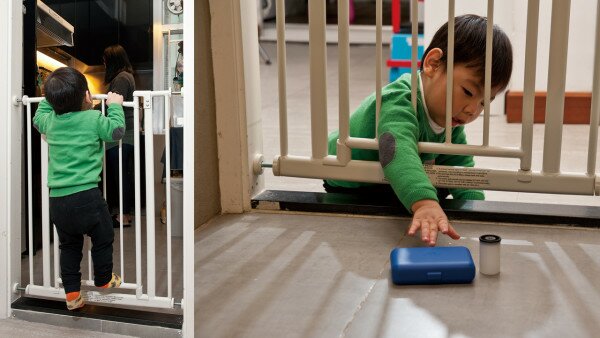Safety gates are used in many homes to prevent young children from getting into dangerous areas to avoid accidents to happen. The Consumer Council conducted a test on 8 models of safety gates available in Hong Kong intended for young children up to 24 months, and found that only 3 have performed well in all test items. Problems with respect to mechanical and physical structure, marking and instructions were found in 4 models, and 1 model was found with migration of total organotin compound at level exceeding the total limit prescribed under European Toy Standard.
According to local Ordinance, safety gates supplied for Hong Kong are required to comply with either the European Standard or the American Society for Testing and Materials Standard, but these two standards have different requirements on the specifications, testing methods, marking and instructions. The Council commissioned an independent laboratory to conduct the tests under the European Standard which has more stringent safety requirements. The 8 models of safety gates tested were priced from $429 to $1,099, with 5 were metal gates, and the others were made of wood, mesh or plastic. The models tested were rated for their safety performance, durability and convenience of use.
The test found that 4 models with claims of auto closing failed to close and lock automatically in all openings. 1 model was found to have gap between the bottom of the gate door and the frame, presenting the risk of fingers or toes entrapment.
A hip probe should not be able to pass between bars in the gate, between the gate and the door frame/wall, or between the gate and the floor, to prevent the possibility of the baby getting stuck in the gap, which could cause suffocation if the baby's torso passed through the gap but not the head. The test revealed that when 2 models were adjusted to full width, a hip probe simulating a 5-month-old baby's hip passed through the gap between the gate and the side of the door frame, and thus failed to meet the European Standard.
Besides, 4 models were deficient in product packaging, marking and instruction manual. Markings and warnings such as "Incorrect installation can be dangerous" or "This safety gate must not be fitted across a window" were missing, which is not up to the European Standard.
The Council also tested for the migration of 19 elements with reference to the more stringent European Toy Standard. In 1 model, 18 mg/kg of organotin compound was found in the plastic material on the mounting pad for securing the safety gate to the side of the door frame or wall, which exceeded the total migration limit12mg/kg under the Standard.
The confirmation test showed the organotin compound in the sample to be mainly mono-methyltin (MeT) compound, which is commonly added to PVC as a stabiliser to prevent deterioration of the plastic from heat and light. Although to date there is no research data regarding the possible health impact of MeT compound on people, animal studies have revealed that intake of water containing MeT compound by lactating mother rats might result in learning deficiencies in breastfed young rats.
Safety gate is a household product that toddlers come into contact with as often as toys. Therefore, there is a risk that the mounting parts of the gate may be sucked, licked, chewed or even swallowed by the toddler if they become detached from the gate because of improper installation, and use or regular pulling and pushing by the toddler. The Council believes that following more stringent safety requirements on product specifications will lead to better protection for young children. In fact, some overseas countries have extended the regulatory control of organotin compounds to general consumer goods, textile products and utensils that come in contact with food.
In respect of durability, all 8 models functioned properly after opening and closing the gate for 4,000 cycles, and they all passed the 1,000-cycle rattle test without any damage, displacement or malfunction. This test simulate a child shaking, pushing or pulling the gate, and the impact on different parts of the safety gate when hit by a child’s body or riding toy.
The prices of safety gates sold online may be cheaper than those sold in physical stores, but consumers should be aware of a possible discrepancy between the images shown online and the real product. Other problems are that the safety gates sold on overseas sites may not meet the regulations and safety standards in Hong Kong, and the name and address of the manufacturer or importer may be missing, making it difficult for consumers to seek for any redresses. Second-hand safety gates may have the additional problems of not coming with any safety guarantee, and of having missing parts or no instruction manual.
The Council advises consumers to pay attention to the following when purchasing and using safety gates:
- Read and follow the instruction for installation and use, and check the safety gate regularly to make sure it is fitted securely and functioning properly;
- Always keep the gate in a closed and locked position to limit your baby’s access to risky areas of your home;
- Adults are warned never to pass the gate by straddling to prevent falls;
- Clean the gate regularly but avoid using a rigid brush or scouring pad as they may cause paint to peel and rust
The Consumer Council reserves all its right (including copyright) in respect of CHOICE magazine and Online CHOICE.




